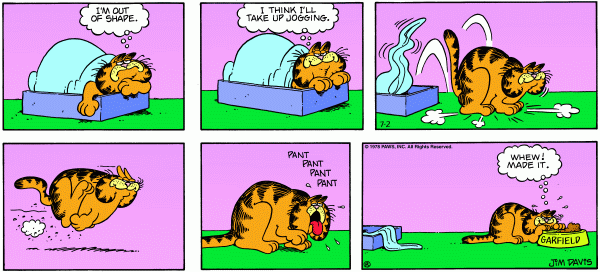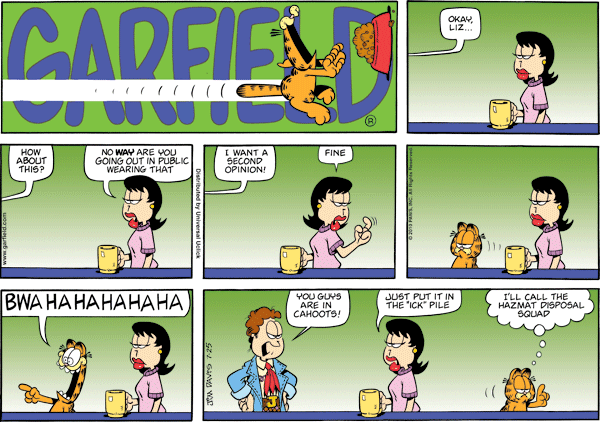CSotD: Profile — Jim Davis
Skip to commentsI’m off getting a magical new hip that will allow me to leap tall buildings in a single bound. While I’m recuperating in a place of dubious connection, here’s an interview I did in 2003 for the Post-Star of Glens Falls, NY. The cartoons were added in 2010 when I replayed the interview for Comic Strip of the Day.
Garfield was born where a lot of cats are born: In the basement.
He sure didn’t stay there.
Jim Davis had worked for nine years as an assistant on the Western-based strip, “Tumbleweeds,” and “Garfield” was not his first attempt to syndicate something of his own.
“I tried one called ‘Gnorm Gnat,'” he confesses. “I thought bugs were funny, and I ran it in a local paper. One (syndicate) editor looked at it and said, ‘Good art, good gags, but I really don’t think people can relate to bugs.’ And, of course …”
Davis laughs at the memory of how right that editor was. “I looked around and saw that dog strips did pretty well, so I thought that maybe a cat might work.”
Indeed, the cat worked pretty well.
“I had no idea of building an empire,” Davis now says, and yet somehow that basement studio has morphed into in a pastoral Indiana setting with a pond and woods that is the workplace of the 55 people who labor on the strip, the books, the coffee mugs, the stick-to-your-window plush dolls and the rest of the empire that is Garfield. Meanwhile, out on the West Coast, a team of special-effect masters are working on a live-action Garfield film with a computer-generated title character.
Despite a lifetime of gluttony and a total lack of cardiovascular exercise, “Garfield” reaches the quarter-century mark this summer, an event that is being marked with the release of a book with the sentimental title, “In Dog Years, I’d Be Dead.”
That well-considered level of rudeness is what has made “Garfield” a hit, particularly with the younger crowd that Davis wants to amuse, attract and maybe educate a little.
“About 12 or 13 years ago, Editor & Publisher did a 20th century comics poll,” he says. “They found that a lot of people who read newspapers said they learned to read through the comics. A third said they had the comics read to them by adults, and another third said they just looked at the pictures until they were able to figure out what the words meant. That was what I did.”
At one point, after he had been drawing “Garfield” for a few years, Davis launched a strip called “U.S. Acres,” which was more directly aimed at young kids and encouraging them to read. The TV series based on the strip still pops up on cable, but the comic strip itself didn’t last.
“I created that strip for kids because, when my son was 5, we were reading the comics and he asked, ‘What’s a transvestite?'” Davis recalls. “I realized there was nothing on the comics page that was written for kids, except a few really lame strips that were maybe written for 2-year-olds.”
Several of his staff members also had kids and “U.S. Acres” got a good start and did well with young readers, but that didn’t make it a success with the people who buy the strips.
“The Boston Globe editor said ‘Kids don’t buy advertising,'” Davis shrugs. “It was just not the right timing, not the right market.”
While that strip was fading, however, “Garfield” was softening a bit, which gave it greater appeal with the young crowd. It was a matter of happenstance, Davis says, as was a kind of physical settling down that also helped draw kids to the strip.
“There was no conscious effort to soften Garfield, but he did soften over time,” he says. “We gave him a teddy bear, and then he also began to become more set in his ways, in the sense that, for instance, you expect to see Snoopy on his doghouse. As Garfield became set in his ways, you also had some of that effect, because, when you’re dealing with a cat who sleeps a lot there isn’t a lot of change in his scenery.”
While simplicity made the strip more accessible to young readers, the increasingly human characteristics of the cat attracted older readers.
“I think every artist needs to find his own reality level,” Davis says. “You dial it up and dial it down until you find the right place, but, oddly enough, the more human I made him, the more catlike people said he was.”
As the popularity of the character has boomed into a marketing phenomenon, Davis has handed over a lot of the daily work to a team of artists, though he continues, with the help of longtime collaborator Brett Koth, to do the gag-writing and editing of the comic strip that kicked off this entire, unintentional empire.
“I have a lot of support on the other parts of the program, and that helps me focus on the strip,” he says.







Comments 1
Comments are closed.